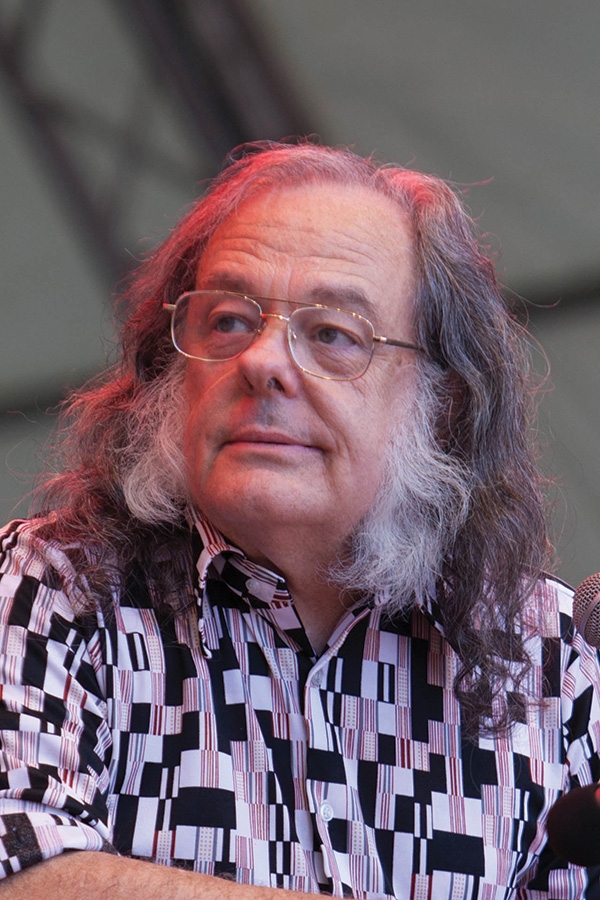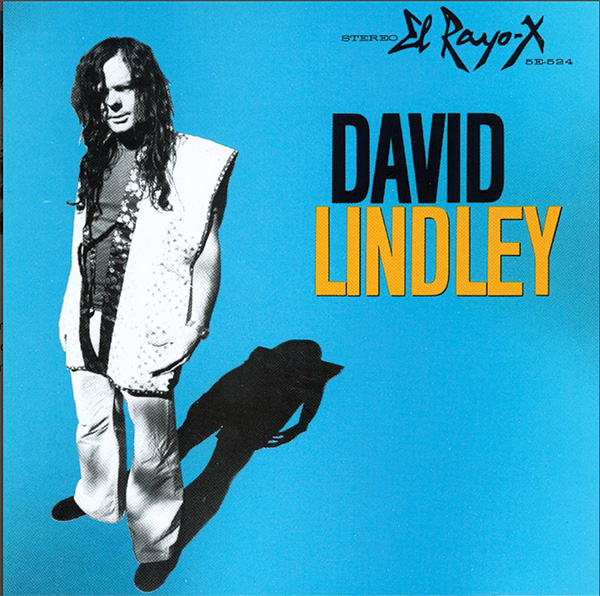| Columns Retired Columns & Blogs |
At one show, he played the song "Copperhead Road" three times in a row, on different instruments and with slightly different arrangements each time.

Before offering a few modest observations about the music, life, and times of David Lindley, a man who never met a stringed instrument he couldn't master and who died on March 3, I'll make two points, both somewhat contrarian.
In the flood of obituaries and tributes that have appeared since his death at age 78, one reads ad nauseam that Lindley, a lifelong Los Angeles resident whose most productive years were the 1970s and '80s, "help[ed] shape the sound of West Coast soft rock," as Guitar Player's writer put it. While Lindley's impact on Jackson Browne, Linda Ronstadt, and other Southern California soft-rockers was indeed considerable, he was equally, if not more, a firebrand, especially on his favorite instrument, the lap-steel guitar, which he essentially introduced to mainstream rock. In fact, it was on a song by one of those masters of mellow, Browne's "Running on Empty," that Lindley gave us one of rock guitar's iconic moments: the swooping lap-steel accompaniment and two scorching solos that one can, without too much exaggeration, be credited with rescuing Browne's flagging career (footnote 1).
And while it's true that Lindley's legacy is primarily that of a sideman, he put together, and led for seven years, El Rayo-X, one of the best 1980s bands, whose five albums, especially the eponymous 1981 debut and its '82 follow-up, Win This Record, provide just as much pleasure today as they did 40 years ago.
Both of these underacknowledged Lindleys—the hard rocker and the savvy bandleader—are on display in the first of a handful of snapshots I've culled from a half-century–plus of excellence on more instruments than Lindley could count, including, in addition to every imaginable kind of guitar, the banjo, fiddle, mandolin, oud, bouzouki, saz, cittern, and zither. "Anything that had strings," Lindley said. Off we go.

1) Ushered in by drummer Ian Wallace's pounding uptempo tom-toms, El Rayo-X's third song, a cover of "Mercury Blues," an all-but-forgotten 1948 number, shows that this band meant business from the start, not least on Lindley's two blazing lap-steel solos. (Like his lifelong friend and colleague Ry Cooder, Lindley scoured the past for obscurities to reimagine.) A YouTube video of an all-star 1999 Red Rocks Amphitheatre performance of "Mercury Blues" (footnote 2) captures a wonderful reversal of the usual scenario: The headliners—Browne, Bonnie Raitt, Bruce Hornsby, and Shawn Colvin—are visibly delighted to stand back and accompany the accompanist's—Lindley's—vocals and scorched-earth steel guitar (footnote 3).
2) For a hard-hitting rock drummer, Ian Wallace had a great feel for the push and pull of reggae and was, moreover, joined in El Rayo-X by the fine Afro-reggae percussionist George "Ras Baboo" Pierre. Lindley's love of reggae (which he unaccountably called "insect music") ran deep, and reggae songs account for fully half of El Rayo-X's dozen tracks, including "Bye Bye Love" (the Everly Brothers—reggae?), "Twist and Shout" (the Isley Brothers—reggae?), and "Don't Look Back" (the Temptations play Trenchtown?).
3) Lindley began his musical life as a 3-year-old violinist, then an accomplished teenaged banjoist who won the venerable Topanga Banjo Fiddle Contest so many times the judges finally invited him to leave. As Lindley once recounted to his protégé, multi-instrumentalist Ben Harper: "They told me, 'Lindley, don't enter anymore.'"
Fully at home among such masters as Mike Seeger and Eric Weissberg, Lindley contributes three songs to the album Feuding Banjos: Bluegrass Banjo of the Southern Mountains (available on all the major streaming services), including "Clinch Mountain Backstep" and "Bluegrass Mountain Medley," both of which demonstrate Lindley's mastery of Scruggs-style three-finger banjo. While not on the level of a contemporary master such as Punch Brothers' Noam Pikelny, Lindley easily polishes off the 16th-note runs that define bluegrass banjo. He frails nice, too.
4) Lindley's humor, typically expressed in a sotto voce, one-eyebrow-raised comment, was legendary. Occasionally he cut loose, as on "Cat Food Sandwiches," a disquisition on the wretched cuisine served touring musicians. In a YouTube video from 2000 recorded in Basel, Switzerland, Lindley and Wally Ingram—a fine drummer, formerly of Timbuk 3—make of "Cat Food Sandwiches" a sort of virtuosic "Alice's Restaurant," a side-splitting monolog packed with spectacular playing.
On Lindley's lap sits a Weissenborn, the eccentric-looking hollow-neck guitar he used for his outings on acoustic lap-steel. His fingerpicking is fascinating to watch, a perpetual-motion, high-speed windmill. But the main attraction is the rap, which gets progressively more revolting: "There's opal beef, oil slick ham, mystery meat look a little like spam/Some kind of vegetable be warm and frayed, ranch dressing, industrial grade." Lindley yells, "Come on, Wally, let's get us some!"
5) One of Lindley's favorite instruments was the pear-shaped, usually 11-string oud, which dates back to the 11th century Middle East. Lindley played the oud across genres and styles, as he does in a 2015 YouTube video shot at the Vangarde Arts Center in Sioux City, Iowa (footnote 4). Looking grandfatherly or at least avuncular at 71, those famous muttonchops gone white, Lindley sings one of the many versions of "Minglewood Blues," first recorded in 1928 by the Memphis band Cannon's Jug Stompers. He plays the fretless instrument with perfect intonation and utter sureness. ("David only got better with age," singer/songwriter/guitarist Robbie Fulks told me recently; footnote 5.) There's nothing the least bit jarring about Lindley's Middle Eastern blues; rather, it conjures the humorous image of a bunch of het-up 1920s Memphians doing the Black Bottom to the old guy's weird-looking, funky-sounding ax.
6) Ry Cooder and Lindley met as teenaged habitués of the Ash Grove folk-and-blues club, a hub of early- and mid-'60s Los Angeles's small but vibrant folk-music scene. (Taj Mahal, a few years older and equally eager to learn all he could about what was not yet known as "roots music," also frequented the place.)
Lindley contributed to more than a half-dozen Ry Cooder albums. (He's on every track of Cooder's best, 1979's Bop Till You Drop.) In the summer of 1995, the two friends and their two musician children—multi-instrumentalist Joachim Cooder and singer Rosanne Lindley—booked themselves a short European tour, including a July 6 concert at the Vienna State Opera that became the two-CD album The Cooder-Lindley Family Live at the Vienna Opera House. For the first half of a seven-minute medley of two R&B classics, Little Milton's "If Walls Could Talk" and Ruth Brown's lustful come-on "5–10–15 Hours," Cooder sings, comps, and solos on his instrument of choice, electric slide guitar, with Lindley unassumingly comping, probably on his Weissenborn. Halfway through, Lindley sings a few verses, plays a short, bracing solo, and Rosanne sashays in on "5–10–15 Hours" to wind things up. A convivial familial evening (footnote 6).
The two guitar geniuses' partnership spanned almost six decades. "If you like roller coasters," Cooder said recently, "then you already know something of what it was like to play with David Lindley. You had to hang on! But let me emphasize: I will remember him not only as a roller-coaster man but as a very sweet man, and kindly. He once gave me a Teisco gold-foil guitar pickup and said it might solve my problem with electric guitar (footnote 7) and the extra-wide Fender Strat C neck, which might improve my clumsy fingering. It was all very casual. Indispensable, as it turned out."

7) Lindley has almost as long and eventful a history with the artist with whom he is most closely identified. "I played with David for the first time in a dressing room at the Troubadour in 1969," Jackson Browne told a reporter in mid-March. "David had his fiddle with him. We started to play my song 'These Days,' and my world changed. His playing was so emotional and immediate—it cast a spell over me and everyone there. It didn't matter that he had never heard the song before."
Between 1973 and 1996, Lindley played on every Browne album but one, from the second, For Everyman, to the 11th (Looking East). Lindley was a regular member of Browne's touring band until 1980, when Browne talked him into going out on his own. ("There are times when I thought it was the craziest and stupidest thing I've ever done," Browne said in 2010.) Browne coproduced, and contributed backup vocals to, the first El Rayo-X album.
Between 1972, when his first album appeared, and the late '70s, Browne's star rose and began to descend. His fourth album, 1976's The Pretender, hints at exhaustion and mid-'70s disillusionment ("I want to know what became of the changes we waited for love to bring"). In "Running on Empty," the exhaustion is right there in the title.
But the energy was back almost at once, as if willed into being (ironically, on an album about the loss of energy): Running on Empty, that first, title, song, kicked into fifth gear by Lindley on his Rickenbacker lap-steel. You can watch Lindley take matters into his own hands in the vividest of the live "Running on Empty" videos that are all over YouTube. In this one (footnote 8), shot in 1978, Browne—fronting a stripped-down band: himself on vocals and rhythm guitar, Lindley, a pianist, a bassist, a drummer, and two backup singers (one the legendary Rosemary Butler)—sings his heart out. Lindley's two solos are entirely different from those on the album; unlike many, if not most, rock'n'rollers, Lindley was all about improvisation, like jazz musicians a composer in real time.
Finally, let's jump three decades, to 2006, when Browne, now 58, and Lindley, 62, played seven concerts in Spain, joined by percussionist Tino di Geraldo and other top Spanish musicians. On the album that captures the tour's highlights, Love Is Strange: En Vivo con Tino (footnote 9), which was released in 2010, Browne and Lindley reach all the way back to 1965, when Browne, just 16, began his first song of note, "These Days." A few years later came "Take It Easy," which Browne cowrote with Glenn Frey of the yet-unborn Eagles; the song became that band's first hit in the summer of '72. On this 2006 version, Lindley plays a rich fiddle accompaniment, repeatedly going against the song's 4/4 grain with eighth-note triplet runs.
Today, when fewer and fewer musicians play actual instruments, musicians like Lindley are receding into the past, along with an immeasurably old and rich tradition whose diminution began in the middle of the last century: the tradition of making music by hand, in real time. Nothing will replace the sounds Lindley made every day of his life, and that Ry Cooder (76) and Taj Mahal (81) continue to make: the sound of fingernails, or a pick, or flesh on wound-metal strings.
Footnote 2: See youtu.be/7umanpQ9sjQ. I would go so far as to suggest that it was only Lindley's somewhat squeaky voice (and, perhaps, lack of consuming ambition) that held him back from solo stardom.
Footnote 3: See youtu.be/eXHlBkg3Mzk.
Footnote 4: See youtu.be/yLq9HgGP8G8.
Footnote 5: See this month's music feature on p.207.
Footnote 6: See youtu.be/ClFZbAiMSbs.
Footnote 7: The Teisco Del Ray was a Japanese-made guitar, long discontinued and prized by such connoisseurs of cheap, eccentric guitars as Cooder and Lindley.
Footnote 8: See youtu.be/V4Q-447zVPY.
Footnote 9: Available on all the major streaming services.

At one show, he played the song "Copperhead Road" three times in a row, on different instruments and with slightly different arrangements each time.

... Werewolves of London?
https://www.youtube.com/watch?v=CQpBhjm4zL8

I remember the gigs in 95 Tony mentions. I was backpacking and living in South London with friends for a few months. The London one was at Royal festival hall. I ran to the stage at the end and asked for the set-list from Joachim. I gave it to an equal Cooder/Lindley fan when I (eventually) got back home.

the guy could really play...
known more within the community of musicians
than by the general listening public